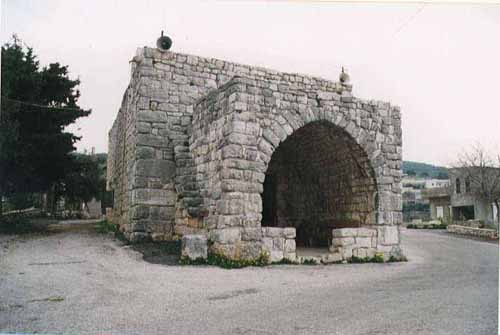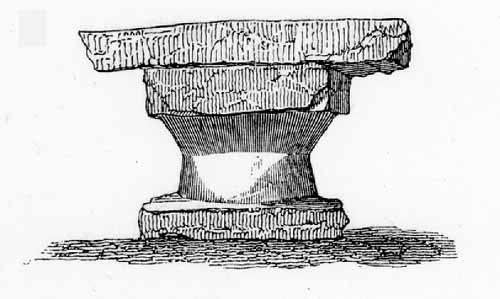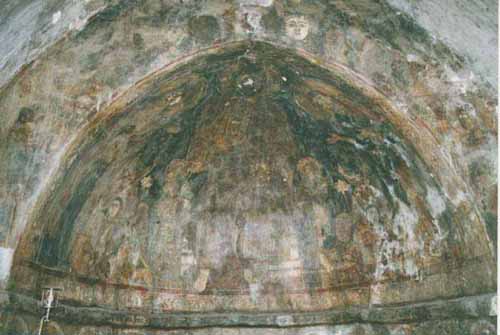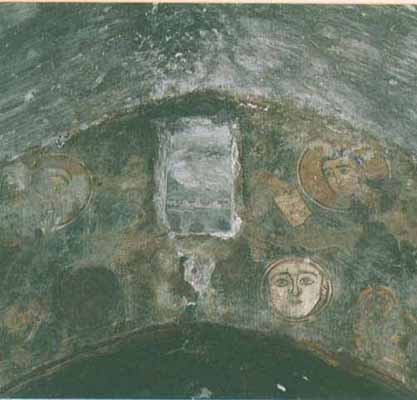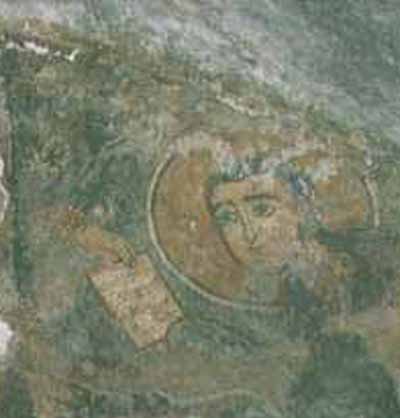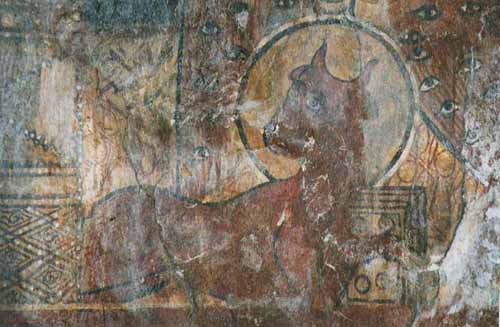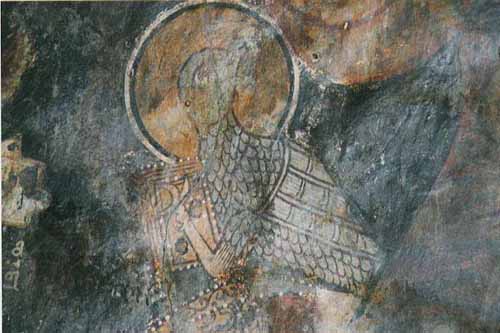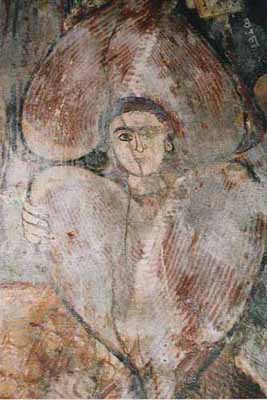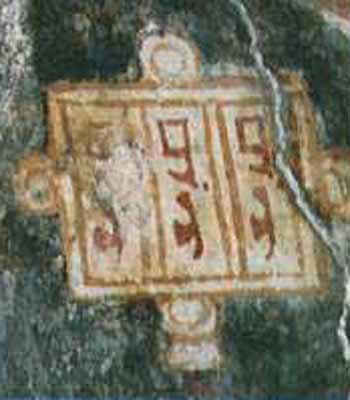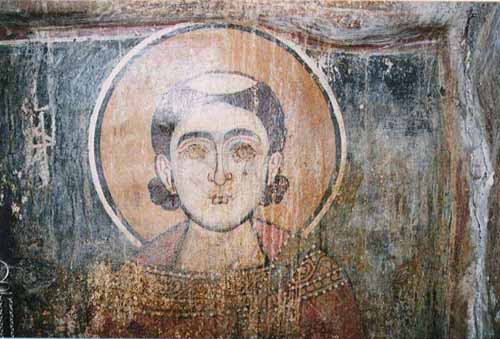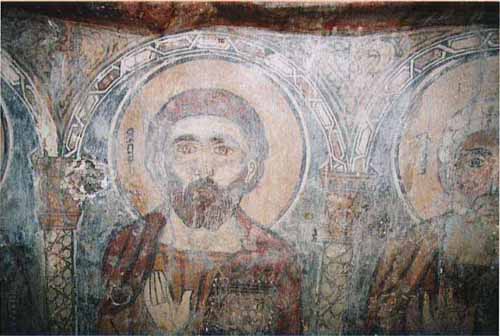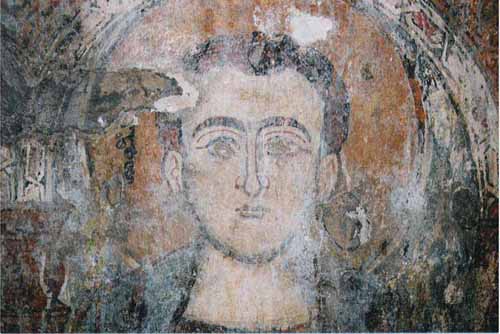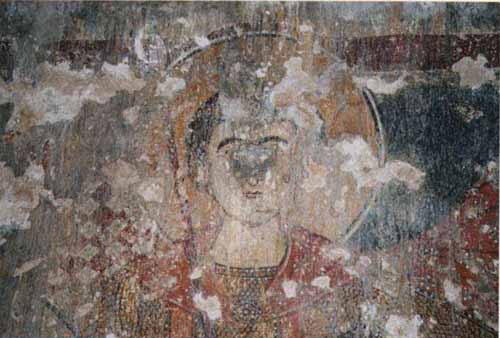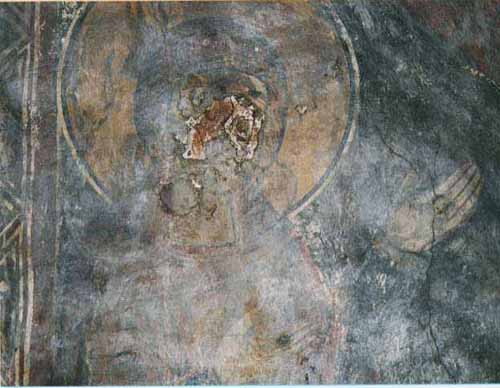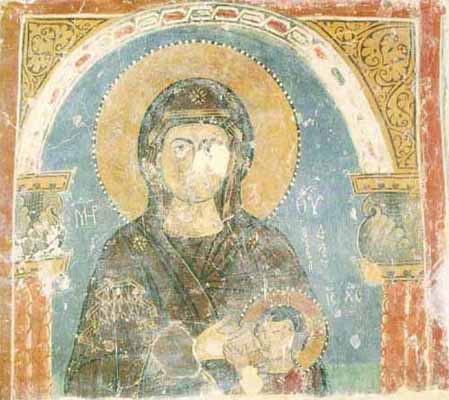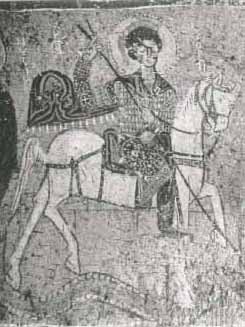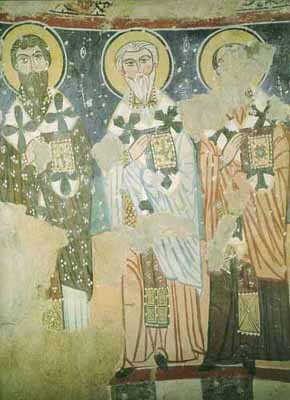By Guita G. Hourani* The Byblos region of Mount Lebanon is a cornucopia of Christian antiquities. During the first century A.D., Byblos and the surrounding area adopted Christianity, and, along with the rest of Lebanon, became a stronghold of the faith. Hundreds of sanctuaries enrich the diverse landscape of the Byblos district, testament to a fervent devotion as vibrant today as it was 2000 years ago. Villages and towns such as Blat, Edde, 'Ebaydat, Jrabta, M'aad, Bahdidat, Smar Jbeil, and Kfar Shleiman house splendid sanctuaries of sacred masterpieces-- murals portraying Emmanuel and frescoes representing the Blessed Virgin Mary, devout apostles, and prominent saints. The most celebrated of these sanctuaries is Saint Theodore's Church in Bahdidat. Located in Mount Lebanon at 550 meters above sea level, 10 kilometers northeast of Byblos, and 47 kilometers northeast of Beirut (1), Bahdidat is now a small forgotten village. Its many antiquities indicate that it had a dynamic history. In his Mission de Phénécie, French traveler Ernest Renan documented his first impression of Bahdidat. "B-hadidat," he said "has a monumental aspect that catches one's first glance. [It has] many antique remnants..." (2). In fact, the name Bahdidat reveals some of its intriguing past. According to Renan "the name itself of B-hadidat seems to have some remnant of paganism. The B initial is without doubt the remains of the word Beth, preserved in Bziza = Beth -Aziz, Beshchtoudar = Beth-Aschtar,... Hadidat probably represents an old name of a divinity, either Phoenician or Syrian." (3) Others think that the name may be of Syriac origin "Bet - Hadkté" or the place of new homes (4). Regardless of the meaning of the name, Bahdidat is blessed with a jewel that stands witness to its ancient glory-- Saint Theodore's Church. The architecture of the Church of Saint Theodore-- known locally as Mar Tadros-- would rank it among the splendid examples of ancient Near Eastern architecture. The magnificent and richly decorated frescoes (5) adorning its walls most greatly impressed Ernest Renan, the French Traveler; Charles Virolleaud, the Head of the Directorate of Antiquities in French mandated Lebanon (1918-1943); and Charles Diehl, the world renowned Byzantine scholar.
These frescoes, that fascinated the traveler and the two scholars, survive in a small structure, 15 meters long and 7 meters wide. The church's distinct architecture is of a paleo-Christian design (6) and of extreme simplicity. Built of stone, the church's basic elements are a prominent square narthex or vestibule, a rectangular nave, and a semi-circular concave-- cul-de-four-- (7) apse. Originally there was one small door but no windows. The interior of Saint Theodore's Church may be described in accordance with the Trinity: the altar is the Holy of Holies; the apse is the Holy Place; and the nave is where the congregation assembles (8). This type of interior design is common to other churches in Mount-Lebanon such as Mar Mama in Ehden, Mar Doumit in Toula, and Saint Sharbel in M'aad (9). The Church's altar, or the Holy of Holies, is at the center of the apse
as the most significant component of the Church. It is a rectangular monolith
(10). According to Renan, this altar is identical to that
of Mar Mama in Ihden (11). It is inscribed with
In churches such as Saint Theodore, Mar Mama, Mar Doumit, and Saint Sharbel the architecture is simple yet noble, but the churches' full expressive value is disclosed (13) through their wall paintings, which complement the architectural space. This is evident by The Dormition (Assumption) of the Virgin religious paintings in M'aad, the murals of Our Lady of Naya in Kfar-Shleiman, and the frescoes of Sayedt-ed-Durr in Becharreh. Fr. Abdo Badwi (14), Director of the Institute of Sacred Art at the Holy Spirit University, in Kaslik, Lebanon, explains that "the murals of Saint Theodore's Church in Bahdidat form a complete iconographic cycle in relation to the apse. This is the composition of the 'Great Supplication' known as Déisis in the Oriental Christian tradition, where Christ Enthroned is surrounded by His Mother on the right and John the Precursor on the left, both turned to Him in prayer." Such Déisis also depicts the protagonists of the Old Testament announcing the Good News fulfilled by Christ in the New Testament (15).
In Bahdidat, the Déisis dominates the vault behind the altar. The entire scene is painted on a blue-gray background. It begins at the top of the apse with an iconographical medallion now damaged and indecipherable because of an opening cut into the fresco. On the sides of the medallion, to the right, there is God's hand with golden yellow sleeve speckled with white paint, like pearls, delivering the Ten Commandments to Moses. To the left side, God's other hand points to Abraham. Fr. Badwi attributes this to be part of the Syriac iconographic tradition "where God the Father is invisible and is never portrayed as a person but, is rather represented by a divine hand."
Next to the medallion, we find the images of Moses, Abraham as an old man with white hair and beard, Isaac as a youth, and the sacrificial lamb. Below the medallion, are the sun in bright light and the moon in total darkness. This "indicates the cosmic presence and the reign of God over everything" as Fr. Badwi explains.
In the center is Christ, seated on a royal red pillow, his feet resting on a similar cushion. He wears a golden yellow robe speckled with white paint, like pearls, on the neck and the sleeves, over which drapes a red crimson parka (16). His right hand is in an outward position giving His blessing, while He carries the Bible in His left. He is presented as the Pantocrator, God the Almighty, or "the most powerful." (17)
Next to Jesus' throne, we recognize the symbols of the four Evangelists, each carrying a Bible. Above and to the right is an angel symbolizing Matthew; below is a red Ox illustrating Luke; above and to the left is an eagle depicting John; and below it is a yellow Lion representing Mark (18).
To the sides of the throne stand the six winged Seraphim and the Cherubim carrying banners with the Trisagion written in beautiful Estrangelo [Syriac] script (19): "Qadish, Qadish, Qadish, (Holy, Holy, Holy)."
Facing each other on the arcade's sides of the curve, to the left we find the Blessed Virgin Mary robed in a blue dress with a crimson color parka, while to the right is John the Baptist wearing a brown garment with dark blue cape. John's hands, like Mary's, are extended in adoration of Christ. On one side of the frieze next to John is Saint Steven the first deacon and martyr. On the other, we see Gabriel, the Archangel, next to the Blessed Virgin and Saint Daniel, the most beloved saint of the Syriac-speaking people, raising his hands toward Christ in invocation.
Further, within the concave of the apse at the lower end of the mural, a sequence of arcs show apostles and evangelists, standing in full figure according to oriental painting physiognomy (one-seventh instead of one-eighth proportion). The name of each disciple and evangelist is inscribed in black painted Syriac Estrangelo script, either in the halo or next to the picture. Simon Peter and Paul are in the center. Standing to the right of Simon Peter are: Mark and John each carrying a Bible, followed by Andrew, two unrecognized pictures, and Thomas. To the right of Paul, we recognize Luke and Matthew carrying each a Bible, followed by one unidentified portrait, and then Jacob and Philip. Their clothes have dominant red, brown, and golden yellow colors and are beautifully decorated. Their faces are rounded and serene, some are bearded and some are not. Their eyes have well-marked pupils. They are elongated with black eyeliner to accentuate their expressiveness. They have an agreeable presence.
On the side walls, we find two equestrian saints: to the right, on a white horse, is Saint George killing the dragon. To the left, on a red horse, is the patron of the church, Saint Theodore. Both horses are galloping toward the apse. Unfortunately, Saint George's eyes were poked out during an incursion by the Muslims into Bahdidat between the XIV-XVI century. Regrettably too, a large portion of the painting of Saint Theodore has been destroyed by the congregation's adding of a window and smearing cement on part of it (20).
Although it has been 900 years or more since Saint Theodore's frescoes were created, the power of the faces, the presence of each person and creature, the position, physiognomy, colors, and symbols all harmoniously and eloquently embody the artists' intended expressions. According to oral history, the Déisis of Saint Theodore's Church of Bahdidat was desecrated between the XIV-XVI century by Muslims. Using their spears, they poked out the eyes of almost every figure in the frescoes, especially Christ's and Mary's, and hacked at the rest of the murals. The damage from this attack has disfigured some faces of the masterpiece and randomly destroyed the beautiful decoration. Furthermore, the constant use of the church, the altering of the walls and the lack of adequate care, proper restoration, and long term maintenance have all contributed to the increasing deterioration of this historic monument.
More than 35 years ago, the Lebanese Directorate of Antiquities did some work on the structure to prevent humidity from damaging the frescoes. However, its use of wax to preserve the paintings has done more harm than good (21). When looking at the murals now, one has the impression of seeing it in the last light of the day when it is in fact mid morning. In terms of its frescoes, "Saint Theodore's Church," said Father Badwi, "belongs to a group of churches of the grand mural period of the tenth to the fourteenth century." Some frescoes belonging to the same period are: M'aad, Kfar Shlieman, Marina, Edde, Kfoun, Hadshit, and Becharreh in Lebanon (22); Nabak (23) and Qarra (24) in Syria; and Cappadocia (25) in Turkey." Several scholars who identified and wrote about the churches of ancient Syria have found that the walls of these churches were covered with paintings; regrettably few of them survived (26). Some of these fragments, like those of Mar Ya'qub (Saint Jacob's Monastery) of Qarra which are now in the Damascus Museum (27), are on display in museums around the world. The frescoes of Bahdidat are of Syriac style with Byzantine elements. They are similar to paintings found in Greek Orthodox or Melkite churches and monasteries throughout ancient Syria, said father Badwi. The most striking resemblance of the sacred art of Saint Theodore of Bahdidat is with that of the Church of Saints Sergius and Bacchus in Qarra in the vicinity of Homs (89 kilometers north of Damascus in today's Syria). The fresco of this church portrays "the Virgin breast-feeding the Infant Jesus and Saint John the Baptist standing under an honoring arcade, and two knights, St. Sergius and St. Theodore, on their horses." (28)
The frescoes of Chapel number 28 at Göreme (29) in Cappadocia, with the image of Jesus Christ, the presentation of apostles and saints, and the depiction of Saint Georges mounted on a horse are remarkably like those ornamenting the walls of Saint Theodore of Bahdidat.
The style of the Syriac monastery of Saint Moses the Ethiopian in Nabak, Syria (81 Kilometers north of Damascus), covers a large portion of the late XII century and includes an earlier decoration dating back to the XI century. It depicts Christ Emmanuel, King, and Pantocrator majestically centered between Mary, the apostles, the saints, and the Fathers of the Church all within the permanence of God the Father who stays invisible. Opposite we see a monumental and detailed interpretation of Judgement Day (30).
Dating and attributing the frescoes of Saint Theodore's Church of Bahdidat is difficult because of the absence of a carbon dating analysis. In his communication before the Academie des Inscriptions et Belles Lettres in Paris in 1927, Charles Diehl stated that the similarities between the frescoes of Bahdidat and Cappadocia and the Syriac inscriptions of the paintings allowed him to believe that the frescoes may be of the tenth or eleventh century. However, for lack of better pictures, he can only date them to the eleventh or twelfth century (31). Fr. Badwi states that the paintings are certainly not Byzantine nor were they done by the Crusaders: the salient graphics, the lack of Byzantine hierarchy, the small size of the apostles and evangelists, and the Syriac inscriptions indicate that they are Syriac (32), and that they have an "oriental touch." (33) Furthermore, "based on a preliminary comparative analysis of the drawings, the physiognomies, the chromatics, and the ornaments of the frescoes in the churches of Syria, Lebanon, and Turkey, we found that there is a distinct school of mural painting that shows apparent characteristics," said Father Badwi. "This lead us to speculate that the frescoes of Saint Theodore's Church are of the tenth, eleventh, or twelfth century," said Father Badwi. In comparison to Italy's Renaissance masterpieces (i.e. Michelangelo's Sistine Chapel ceiling in the Vatican, Leonardo da Vinci's Last Supper in Milan, and Masaccio's frescoes in Santa Maria del Carmine Church in Florence of the late 1700 A.D.), which have been undergoing massive restoration since they were first painted, the frescoes of Bahdidat remain after over 900 years a breathtaking achievement reflecting splendid craftsmanship. Despite the destruction and the wear and tear, Saint Theodore's murals have retained their colors and shapes without any intervention or restoration. Leonardo's Last Supper has alone undergone "six major restorations since 1726." (34) Bahdidat's frescoes can be restored to their original magnificence using today's innovative restoration techniques. Their restoration should involve much more than covering the cracks, dabbing fresh paint, or spreading glue over faded images. It should include revitalizing the scenes, and collecting much information on style, pigmentation, techniques, and design of this Syriac heritage of fresco design. Ultraviolet and X-rays, computer stress printouts, and analysis of pigment samples to recreate colors should be employed to obtain such information. (35) Much can be learned from the technologies applied in the restoration of Leonardo's Last Supper as described by the Chief Restorer Dr. Pinin Brambilla Barcilon: "We have applied stereophoto-grammetry, the technique cartographers use in making aerial topographical maps, to create in essence a relief map of the paint on the wall. Using ultrasound, we have made a profile of the thickness of the wall . This let us find little craters and pick out places where the priming is lacking and only bare wall remains. With hygrometers, infrared cameras, and electronic sensors we have made detailed temperature and humidity profiles. We hope sophisticated new techniques that detect radioactive isotopes will reveal whether there is humidity between the layers of paint, the priming, and the mortar. We have applied X-ray and ultraviolet techniques that can identify the minerals used in Leonardo's pigments. It is partly a way of discovering his craftsmanship..." (36) Dr. Brambilla Barcilon also stated that the primary goal for using all these technologies, was to "describe the painting and its environment in scientifically accurate terms, to create a data bank for future generations as well as for today's." (37) These are some of the techniques and technologies that can be employed in the restoration of Bahdidat's frescoes to enrich our knowledge to share it with the rest of the world. It is certain that restoration of such masterpieces is quite an undertaking and is expensive. Such an activity is usually a joint venture among universities, non-profit organizations, governments, and museums. Funds needed to cover the expenses of such an endeavor are usually contributed by the private sector and partially covered by royalties from audio-visual productions, posters, books, etc. The restoration costs of the Last Supper were mainly covered by the Olivetti Corporation. As for Michelangelo's Sistine Chapel, the Nippon Television Network Corporation (NTNC) of Tokyo offered the Vatican $3 million in support of this project. According to NTNC it was "in exchange for exclusive world rights to the reproductions of the 'new' Sistine Chapel frescoes in any form-- from art book to calendar page, from videotape to postcard-- for three years after the restoration of each phase." (38) Saint Theodore's Church, wrote Renan, "is worthy of attention. It is ancient, and the paintings that decorate its interior can pass as the most precious specimen of Syrian art." (39) In 1926-1927, and after Charles Virolleaud had read Renan's account on the frescoes of Bahdidat, he commissioned an Armenian artist, Monsieur Tutundjian, to reproduce the frescoes in watercolors (40). He then sent the watercolors to the Academie des Inscriptions et Belles-Lettres in Paris, where Charles Diehl made his famous comments on these frescoes before the Academie during the Séances de l'Année 1927. Diehl stated that these frescoes seem very interesting and deserve merit. (41) One can only imagine what the restoration of the Déisis of Bahdidat will reveal, what the expression on Christ's face will be, how glorious He will look in his cleaned red cloak, how beautiful the angels will be, and how piercing or gentle the eyes of Mary and the apostles will be. Renan was impressed and he only saw the paintings of the vault, but not of the apse and the side walls. Virolleaud saw the fresco in its worst condition. I am sure that Renan and Virolleaud would have liked to have seen Bahdidat's wounds doctored and the true spirit and expression of this sacred art revealed. Once restored, Bahdidat will unveil 900 years of faith, spiritual legacy, artistic and religious maturity, simplicity, and dignity. It will also enhance our confidence and that of the future generations in their noble Eastern Christian heritage. Planned correctly, a restoration could contribute to an increase in 'religio-tourism' and play an important role in the spiritual and economic revival of Lebanon. *Guita G. Hourani is a Fellow at the Institute of Christian Oriental Research at the Catholic University of America and the President of MARI. (1) Merhege, A. I'raf Lubnan, (Lebanon, 1971, 1972), Vol. II, p. 109. | Back to text | (2) Renan, E. Mission de Phénécie, (Paris, 1864), p. 236. | Back to text | (3) Renan, p. 238. | Back to text | (4) Merhege, p. 110. | Back to text | (5) Although the style of the wall paintings of Bahdidat have not yet been determined 'frescoes' stricto sensu, in this article we will use the words murals and frescoes interchangeably to mean the wall paintings. | Back to text | (6) Architecture Maronite, Encyclopedie Maronite, (Beirut, 1992), p. 378. | Back to text | (7) Architecture Maronite, p. 378. | Back to text | (8) Duwaihi, I. Patriarch, Manarat al-Aqdas, (Beirut, 1895), p.103. | Back to text | (9) Duwaihi, p. 103. | Back to text | (10) Architecture Maronite, p. 378. | Back to text | (11) Renan, p. 237. | Back to text | (12) Renan, p. 229. | Back to text | (13) Architecture Maronite, p. 378. | Back to text | (14) Father Abdo Badwi was specially interviewed for this article, (Lebanon, March 2, 1997). | Back to text | (15) See also Icônes du Liban, Centre Culturel du Panthéon, (Paris, 1996), p. 31, 36, and 46. | Back to text | (16) Diehl, Ch. Communication in Comptes Rendus of the Academie des Inscriptions et Belles-Lettres, Séances de l'Année 1927, (Paris, 1927), pp. 328-329. | Back to text | (17) Diehl, Ch., Manuel d'Art Byzantin, Vol. 2, (Paris, 1926), p. 846-847. For further reading we suggest: Wessel, K. Das Bild des Pantokrator, (Heidelberg, 1966); Jones, E., The Pantocrator, Eastern Churches Quarterly, Vol. XI, (1951-1952), pp. 266-272; and Cappazi, C. Pantocrator, in Coll. Orientalia Christiana Analecta, No 170, (Rome, 1964). | Back to text | (18) Icônes du Liban, p.46. | Back to text | (19) Renan, p. 236. | Back to text | (20) Tallon, M., Une Eglise Libanaise à Peintures Célèbres: St. Tâdros de Bahdidat, in Arabic, Al-Machriq, Vol. 3, May-June, 1970, pp. 281-282; Merhege, A. I'raf Lubnan, (Lebanon, 1971, 1972), Vol. II, pp. 110-111; and Diehl, pp. 328-329. | Back to text | (21) Tallon, p. 281. | Back to text | (22) Leroy, J. Les Manuscripts Syriaques à Peintures, (Paris, 1964), p. 83. | Back to text | (23) See Burns, R. Monuments of Syria: An Historical Guide, (New York, 1992). Also spelled as Nbak, Nbek, Nabk, Nebk, Nebek, and Nebak. | Back to text | (24) See Harvey, W. Ed. Ebla to Damascus: Art and Archaeology of Ancient Syria, (Washington, D.C., 1985). Also spelled as Qara. | Back to text | (25) See Jerphanion, G. De, Les Eglises Rupestres de Cappadoce, (Paris, 1925, 1928, 1934). Also called Cappadoce. | Back to text | (26) Lassus, J. Sanctuaires Chrétiens de Syrie, (Paris, 1947), pp. 299-302. Also see Lassus, J. Inventaire Archéologique de la Région au Nord-Est de Hama, 2 Vols. (Paris 1935, 1936); De Vogüé, M. Les Eglises de la Terre Sainte, (Paris, 1860);Tchalenko, G., Elgises de Village de la Syrie Du Nord, 2 Vols. (Paris, 1979, 1980); Burns, R. Monuments of Syria: An Historical Guide, (New York, 1992); Coche de la Ferté, E. L' Antiquité Chrétienne au Musée du Louvre, (Paris, 1958); Stierlin, H. Orient Byzantin: De Copnstantinople à l'Arménie et de Syrie en Ethiopie, (Paris, 1988); and Sournia, J. and Sournia, M. L' Orient des Pemiers Chrétiens, (Paris, 1966). | Back to text | (27) Harvey, p. 462. | Back to text | (28) Zibawi, M. Orients Chrétiens, (Paris, 1995), p. 92. | Back to text | (29) Also spelled Gueurémé. | Back to text | (30) Zibawi, p. 92. | Back to text | (31) Diehl, p. 330. | Back to text | (32) Renan, p. 236. | Back to text | (33) Zibawi, p. 92. | Back to text | (34) Bertelli, C. Restoration Reveals the Last Supper, National Geographic, (November, 1983), p. 674. | Back to text | (35) Armstrong, G. Lifting the Veil: Technology Throws a New Light on the Renaissance, Modern Maturity, Vol. 34, (Feb-March, 1991), p. 48-46. | Back to text | (36) Bertelli, p. 683. | Back to text | (37) Bertelli, p. 683. | Back to text | (38) Armstrong, p. 56. | Back to text | (39) Renan, p. 236. | Back to text | (40) Allen, J. Ed. Literature on Byzantine Art 1892-1967, Vol. 1, Part 1, (Washington, D.C. , 1973), p. 77; Diehl, p. 328-329; and Tallon, p. 282. | Back to text | (41) Diehl, p. 330. | Back to text | |
